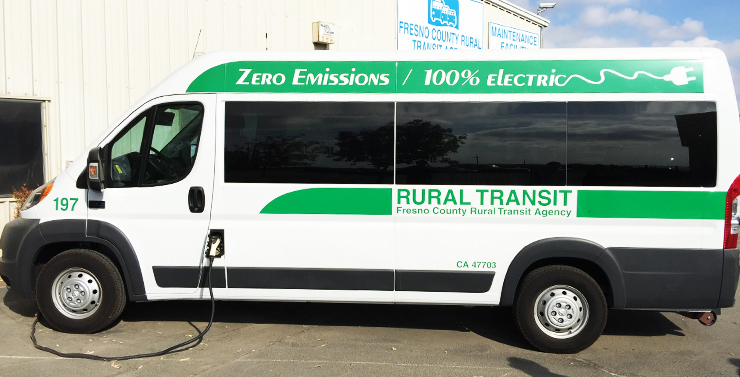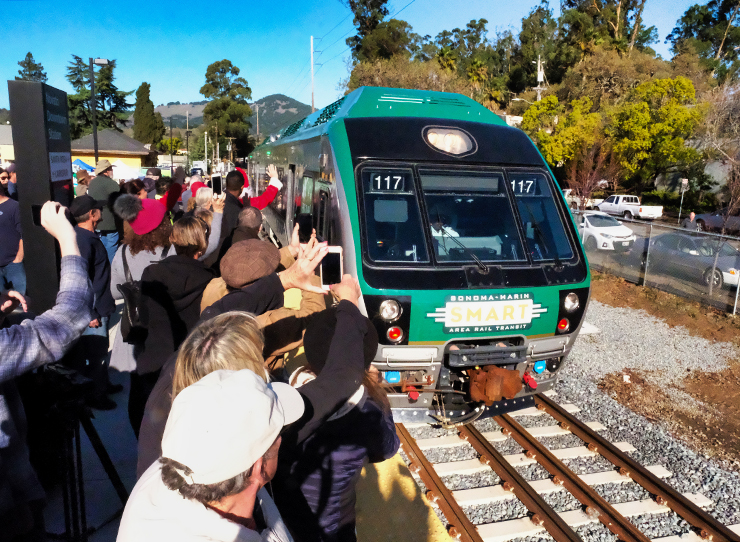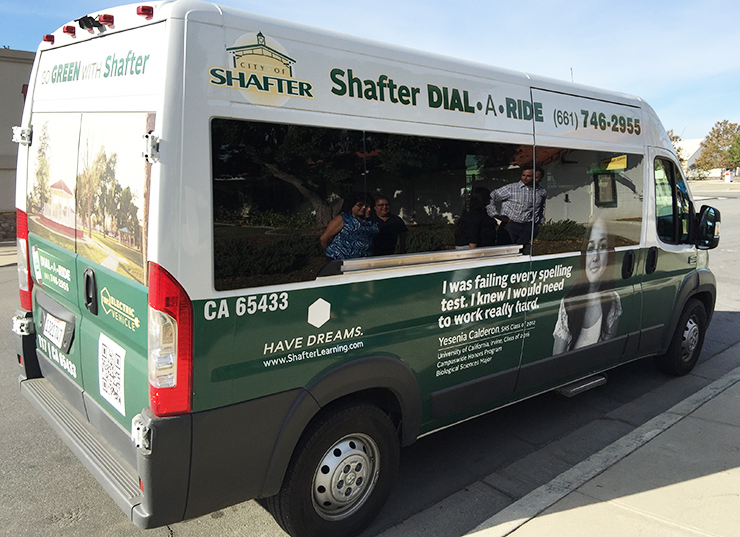Clean-Air Travel Options Expanding
Most Planned Rail, Transit Projects Will Help Underserved Communities

A robust slate of public transportation projects to give Californians improved alternatives to driving in their vehicles, as well as delivering cleaner air, was approved with funding from two programs administered by Caltrans.
The California State Transportation Agency (CalSTA) recently awarded $500 million to 17 projects around the state through the Transit and Intercity Rail Capital Program, known as TIRCP. The funds are part of a $5.8 billion effort to help modernize California’s intercity, commuter and urban rail service, and bus and ferry systems through fiscal year 2024-25.

In a separate action, Caltrans announced in July that it approved $146 million in Low Carbon Transit Operation Program (LCTOP) funds for 166 transit and light-rail projects in California.
The two programs share similar goals, and have a common funding source: proceeds from California’s “Cap-and-Trade” Greenhouse Gas Reduction Fund that raises money through the auction of carbon tax credits. The aim of TIRCP and LCTOP is to increase transit ridership, reduce greenhouse gas emissions and prioritize disadvantaged communities.
TIRCP was created by legislation in 2014 to fund transformative capital projects that reduce greenhouse gases, expand transit ridership through better service, improve safety, and integrate rail and transit services. The program is intended to improve public transit, draw drivers out of their vehicles, reduce harmful emissions, and contribute to TIRCP’s overall strategy of reducing highway congestion and the overall amount of vehicle miles traveled in California.
In addition, TIRCP receives funds through the Road Repair and Accountability Act of 2017 (SB 1), projected to generate about $1.4 billion through 2027.

Like TIRCP, LCTOP was established in 2014 and invests in providing cleaner, better, and more accessible transit opportunities in the state. The LCTOP was created to provide operating and capital assistance for transit agencies to reduce greenhouse gases and improve mobility, with a priority on serving disadvantaged communities. Approved projects in LCTOP support new or expanded bus or rail services, expand intermodal transit facilities, and may include equipment acquisition, fueling, maintenance and other costs to operate those services or facilities.
Caltrans works closely with the California Air Resources Board and State Controller’s Office on LCTOP goals and to ensure that the statutory requirements of the program are met in terms of project eligibility, greenhouse gases reduction, disadvantaged community benefit, and other requirements of the law.
Both TIRCP and LCTOP are required by law to award transportation projects that benefit populations defined as disadvantaged or low-income in Assembly Bill 1550. All 17 TIRCP projects and nearly all LCTOP projects will provide benefits to disadvantaged communities.
Here are some of the rail and transit projects that will be funded under each program:
TIRCP
Of the 17 projects selected for funding through the 2024-25 fiscal year, nine will be in Southern California, five in Northern California, and three in Central California. It’s estimated that the projects together will prevent more than five million metric tons of greenhouse gases from spewing into the air.
Southern California:
The largest award went to the Metrolink Antelope Valley Line Capital and Service Improvements project. CalSTA awarded $107 million in TIRCP funding to the $220 million project to expand and improve commuter train service between Los Angeles and the Lancaster-Palmdale area, where one-third of the residents are considered disadvantaged. Four infrastructure projects will increase the frequency of service and a zero-emissions train pilot is planned. The completion date is 2027.

Northern California:
The Transbay Corridor Core Capacity Program was awarded $107 million in TIRCP funding, the most of the five approved NorCal projects. Combined with a previous award in 2018, TIRCP is slated to contribute a total of $425.7 million to the Bay Area Rapid Transit (BART) expansion project, scheduled to be completed by 2031. The TIRCP awards are contingent upon a federal funding agreement.
The BART project would add 34 new cars to its fleet, for a total of 306, allowing more frequent service and increasing passenger capacity, particularly between the East Bay and San Francisco. Almost one-third of BART stations are in areas defined as disadvantaged.
Central California:
Sacramento Regional Transit (SacRT) will receive $23.6 million to continue its nearly $600 million modernization and expansion program. Combined with a 2018 TIRCP grant and SB 1 revenues, the total allocated to SacRT for its work will be $64.4 million. The Sacramento transit agency is adding 28 new low-floor light rail cars to its fleet, expected to increase ridership, and improve station access by 2024. Of SacRT’s 52 light-rail stations, 41 are in disadvantaged areas.
See a complete list of TIRCP allocations and project descriptions.
LCTOP

This year’s LCTOP funding process took place during the COVID-19 pandemic, and some projects were revised to fit emerging health and safety priorities. For example, some agencies expanded dial-a-ride and fare-free services to increase access and protection for their riders and operators.
Of the 166 funded projects:
- 55 will offer free or reduced fares to encourage lifelong transit users, including young riders, seniors and veterans:
- City of Los Angeles: $1.37 million for the second operating year of free fares on Los Angeles Department of Transportation Downtown Area Short Hop services for students attending Los Angeles Unified School District and Los Angeles Community College.
- San Joaquin and Stanislaus counties: $1.79 million for nine projects to expand free or reduced fares.
- Monterey-Salinas Transit: $846,826 for six projects to allow free weekend fares in Salinas, summer youth passes, and free fares for college students.
- North Coast transit agencies including the city of Arcata, Humboldt Transit Authority, and Lake Transit Authority: $339,997 for three projects offering free fares to populations that include low-income residents, youths and college students.
- 37 to provide new and expanded transit service for better access to jobs and educational sites, and expand transit options on nights and weekends:
- Sacramento Regional Transit: $3.38 million for four projects that include core bus routes and enhancing light rail from the Sunrise station to Folsom.
- Fresno Department of Transportation: $832,746 for changes to five bus routes and the creation of a new route.
- Kings County Area Public Transit Agency: $118,000 to increase bus frequencies on eight weekday routes.
- Ventura County Transportation Commission: $550,000 for continuation of the new Cross County Transit Service connecting communities in eastern and western Ventura County serving low-income populations.
- 26 involve zero-emission vehicles:
- San Diego Metropolitan Transit System and North County Transit District: $8.42 million for continued projects to purchase zero-emission buses.
- City of Arvin: $41,362 to complete its fourth year of roll-over funding to replace diesel buses with zero-emission versions and install charging stations.
- Livermore Amador Valley Transit Authority: $471,778 to purchase four zero-emission buses and provide necessary improvements to replace diesel-electric hybrid buses at the end of their lifespan.
- 14 authorize more passenger amenities at transit stops/stations to increase transit ridership:
- Siskiyou County: $84,191 for upgrades to 50 bus stops to add schedule holders and perform Americans with Disabilities Act (ADA) concrete work.
- Mountain Area Regional Transit Authority: $102,167 to improve bus stops in the Big Bear-Lake Arrowhead region by including ADA-compliant access, better weather protection, and seating accommodations for disabled and senior riders.
- Plumas County Transportation Commission: $38,973 to construct solar-illuminated bus stop shelters.
See complete list of LCTOP allocations and project descriptions.
Source: Caltrans Division of Rail and Mass Transportation.

